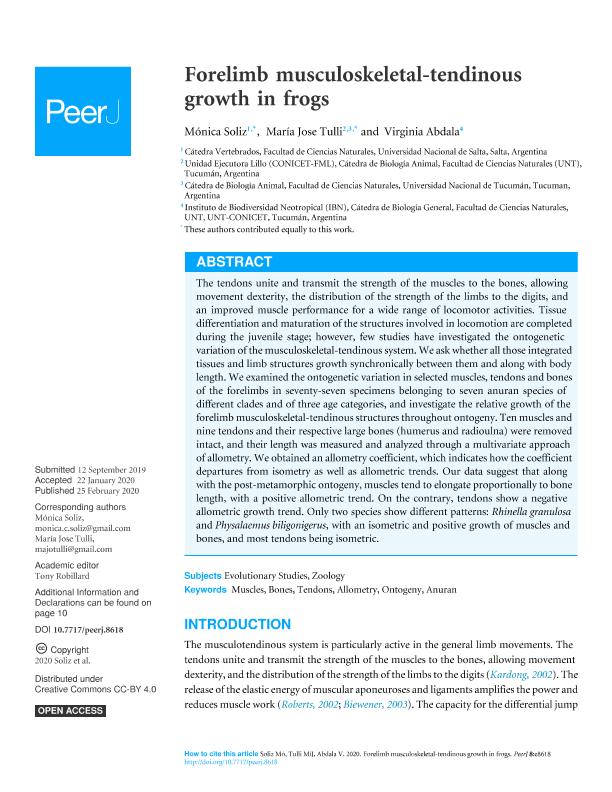Mostrar el registro sencillo del ítem
dc.contributor.author
Soliz, Mónica Elizabeth

dc.contributor.author
Tulli, María José

dc.contributor.author
Abdala, Virginia Sara Luz

dc.date.available
2021-11-09T17:51:42Z
dc.date.issued
2020-02-25
dc.identifier.citation
Soliz, Mónica Elizabeth; Tulli, María José; Abdala, Virginia Sara Luz; Forelimb musculoskeletal-tendinous growth in frogs; PeerJ; PeerJ; 2020; 2; 25-2-2020; 1-14
dc.identifier.uri
http://hdl.handle.net/11336/146462
dc.description.abstract
The tendons unite and transmit the strength of the muscles to the bones, allowing movement dexterity, the distribution of the strength of the limbs to the digits, and an improved muscle performance for a wide range of locomotor activities. Tissue differentiation and maturation of the structures involved in locomotion are completed during the juvenile stage; however, few studies have investigated the ontogenetic variation of the musculoskeletal-tendinous system. We ask whether all those integrated tissues and limb structures growth synchronically between them and along with body length. We examined the ontogenetic variation in selected muscles, tendons and bones of the forelimbs in seventy-seven specimens belonging to seven anuran species of different clades and of three age categories, and investigate the relative growth of the forelimb musculoskeletal-tendinous structures throughout ontogeny. Ten muscles and nine tendons and their respective large bones (humerus and radioulna) were removed intact, and their length was measured and analyzed through a multivariate approach of allometry. We obtained an allometry coefficient, which indicates how the coefficient departures from isometry as well as allometric trends. Our data suggest that along with the post-metamorphic ontogeny, muscles tend to elongate proportionally to bone length, with a positive allometric trend. On the contrary, tendons show a negative allometric growth trend. Only two species show different patterns: Rhinella granulosa and Physalaemus biligonigerus, with an isometric and positive growth of muscles and bones, and most tendons being isometric.
dc.format
application/pdf
dc.language.iso
eng
dc.publisher
PeerJ
dc.rights
info:eu-repo/semantics/openAccess
dc.rights.uri
https://creativecommons.org/licenses/by-nc-sa/2.5/ar/
dc.subject
ALLOMETRY
dc.subject
ANURAN
dc.subject
BONES
dc.subject
MUSCLES
dc.subject
ONTOGENY
dc.subject
TENDONS
dc.subject.classification
Biología

dc.subject.classification
Ciencias Biológicas

dc.subject.classification
CIENCIAS NATURALES Y EXACTAS

dc.title
Forelimb musculoskeletal-tendinous growth in frogs
dc.type
info:eu-repo/semantics/article
dc.type
info:ar-repo/semantics/artículo
dc.type
info:eu-repo/semantics/publishedVersion
dc.date.updated
2021-08-25T19:31:24Z
dc.identifier.eissn
2167-8359
dc.journal.volume
2020
dc.journal.number
2
dc.journal.pagination
1-14
dc.journal.pais
Estados Unidos

dc.journal.ciudad
Nueva York
dc.description.fil
Fil: Soliz, Mónica Elizabeth. Universidad Nacional de Salta. Facultad de Ciencias Naturales. Cátedra de Anatomia Comparada; Argentina
dc.description.fil
Fil: Tulli, María José. Consejo Nacional de Investigaciones Científicas y Técnicas. Centro Científico Tecnológico - Tucumán. Unidad Ejecutora Lillo; Argentina
dc.description.fil
Fil: Abdala, Virginia Sara Luz. Consejo Nacional de Investigaciones Científicas y Técnicas. Centro Científico Tecnológico Conicet - Tucumán. Instituto de Biodiversidad Neotropical. Universidad Nacional de Tucumán. Facultad de Ciencias Naturales e Instituto Miguel Lillo. Instituto de Biodiversidad Neotropical. Instituto de Biodiversidad Neotropical; Argentina
dc.journal.title
PeerJ
dc.relation.alternativeid
info:eu-repo/semantics/altIdentifier/url/https://peerj.com/articles/8618
dc.relation.alternativeid
info:eu-repo/semantics/altIdentifier/doi/http://dx.doi.org/10.7717/peerj.8618
Archivos asociados
